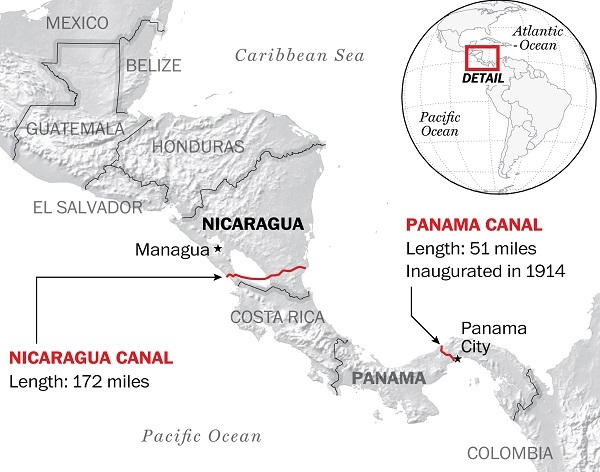January 13, 2015 – A 277 kilometer (172 mile) proposed interoceanic canal, the proposed route seen on the map below, represents one of the most ambitious infrastructure projects to be undertaken this century. The estimated cost is $50 billion USD. For Nicaragua it potentially means a doubling of the gross domestic product (GDP) of the nation. But it also may lead to the destruction of the ecology and environment of Lake Nicaragua and surrounding wetlands and rivers.

A Hong Kong-listed company, HKND, will operate the canal. They were granted, some say a 50-year, and others a 100-year concession in agreeing to not just build but finance it as well. The estimated time to completion is five years. Construction will require the uprooting of a number of indigenous communities. But potentially much worse is the emergence of an ecological disaster for the wetlands, forests and lake that is one of only a few tropical freshwater lakes in the world. Fisheries will be impacted. Invasive species from the Caribbean Sea will likely enter Lake Nicaragua. Dredging of the lake bottom will do even more environmental damage.
All of this undertaking has been done without an environmental assessment and scientists are concerned. A group of them representing the InterAmerican Network of Academies of Science, the Nicaraguan Academy of Sciences, and the International Council for Science got together in November and issued a warning of “unintended adverse consequences.”
Why is Lake Nicaragua at risk? It is not really a suitable lake for the transit of large ships. This isn’t the Great Lakes of North America, each hundreds of meters deep. Lake Nicaragua is shallow with an average depth of 12.5 meters (41 feet). The plan calls for the dredging 105 kilometers of the lake bottom to a depth of 30 meters (just under 100 feet). Dredging will lead to higher concentrations of suspended particles in the lake and may introduce no bacterial contaminants to the lake bed. This is of concern not just for the ecology of the lake but also because it is the principal source of fresh drinking water for much of the centre of the country.
The scientists who met in Managua, Nicaragua’s capital city, expressed concern that “special protection meeasures are needed to conserve the present good water quality.” There is a fear that construction will introduce contaminants, and subsequently so will the ships that pass through the lake.
The project calls for the creation of an artificial 395 square kilometer (152 square mile) lake and hydroelectric installation to provide power for the canal’s locks. The plan is to divert water from Lake Nicaragua to fill this artifical lake. This will further impact the rivers feeding the lake and the wetlands surrounding it, lowering water tables.
The scientists have a solution. They propose an alternate route for the canal, one that does not include the lake. Their revised route will be be more expensive to build but they argue that it “would be cheaper in the long run, given the costs of mitigating the potential environmental damages.”
Today Nicaragua is the poorest country in Central America, and second poorest in the Western Hemisphere. The economy is heavily agricultural. Its principal crop is coffee. It also produces sugar, peanuts and cotton. Currently it has seen a 33% decline in its principal export, coffee because of rust fungus. GDP is estimated at $4,500 USD with more than 40% of the population classified as impoverished. The building and operating of the canal, therefore, could mean a lot for the country. The question is, not that a canal be built, but that the current plan for the canal be revised and a proper environmental assessment be conducted to choose a better and safer route.











